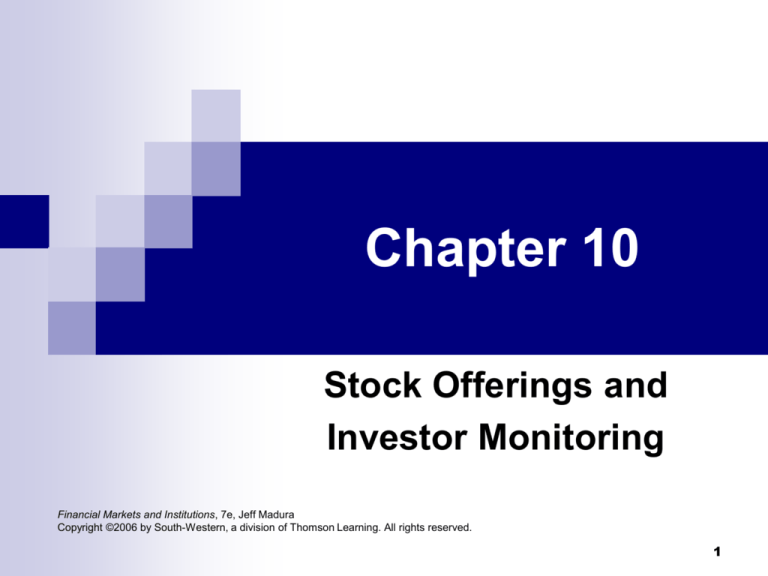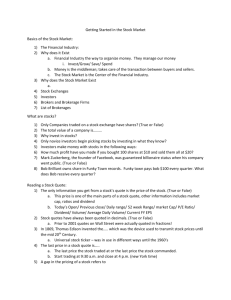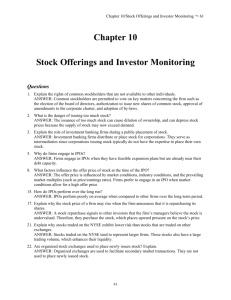
Chapter 10
Stock Offerings and
Investor Monitoring
Financial Markets and Institutions, 7e, Jeff Madura
Copyright ©2006 by South-Western, a division of Thomson Learning. All rights reserved.
1
Chapter Outline
Background on stock
Initial public offerings
Secondary stock offerings
Stock exchanges
Investor participation in the secondary market
Monitoring by investors
The corporate monitoring role
Globalization of stock markets
2
Background on Stocks
A stock is a certificate representing partial ownership in a
corporation
Stock is issued by firms to obtain long-term funds
Owners of stock:
Can benefit from the growth in the value of the firm
Are susceptible to large losses
Individuals and financial institutions are common purchasers of
stock
The primary market enables corporations to issue new stock
The secondary market creates liquidity for investors who invest in
stock
Some corporations distribute earnings to investors in the form of
dividends
3
Background on Stocks (cont’d)
Ownership and voting rights
The
owners are permitted to vote on key matters
concerning the firm:
Election of the board of directors
Authorization to issue new shares
Approval of amendments to the corporate charter
Adoption of bylaws
Voting
is often accomplished by proxy
Management typically receives the majority of the
votes and can elect its own candidates as directors
4
Background on Stocks (cont’d)
Preferred stock
Preferred stock represents an equity interest in a firm that
usually does not allow for significant voting rights
A cumulative provision on most preferred stock prevents
dividends from being paid on common stock until all preferred
dividends have been paid
Preferred stock is less risky because dividends on preferred
stock can be omitted
Preferred stock is a less desirable source of funds than bonds
because:
Dividends are not tax deductible
Investors must be enticed to purchase the preferred stock since
dividends do not legally have to be paid
5
Background on Stocks (cont’d)
Issuer participation in stock markets
The
ownership feature attracts many investors who
want to have an equity interest but do not
necessarily want to manage their own firm
A firm issuing stock for the first time engages in an
IPO
If a firm issues additional stock after the IPO, it
engages in a secondary offering
6
Initial Public Offerings
An IPO is a first-time offering of shares by a
specific firm to the public
Usually, a growing firm first obtains private
equity funding from VC firms
An IPO is used to obtain new funding and to
offer VC firms a way to cash in their investment
Many
VC firms sell their shares in the secondary
market between 6 and 24 months after the IPO
7
Initial Public Offerings (cont’d)
Process of going public
An investment banking firm normally serves as the lead
underwriter for the IPO
Developing a prospectus
The issuing firm develops a prospectus and files it with the SEC
The prospectus contains detailed information about the firm and
includes financial statements and a discussion of risks
The prospectus is intended to provide investors with the
information they need to decide whether to invest in the firm
Once approved by the SEC, the prospectus is sent to institutional
investors
Underwriters and managers meet with institutional investors in the
form of a “road show”
8
Initial Public Offerings (cont’d)
Process of going public (cont’d)
Pricing
The offer price is determined by the lead underwriter
During the road show, the number of shares demanded at
various prices is assessed
Bookbuilding
In some countries, an auction process is used for IPOs
Transaction costs
The issuing firm typically pays 7 percent of the funds raised
The lead underwriter typically forms a syndicate with other
firms who receive a portion of the transaction costs
9
Initial Public Offerings (cont’d)
Underwriter efforts to ensure price stability
The lead underwriter’s performance can be measured by the
movement in the IPO shares following the IPO
If stocks placed by a securities firm perform poorly, investors may
no longer purchase shares underwritten by that firm
The underwriter may require a lockup provision
Prevents the original owners from selling shares for a specified
period
Prevents downward pressure
When the lockup period expires, the share price commonly
declines significantly
10
Initial Public Offerings (cont’d)
Timing of IPOs
IPOs tend to occur more frequently during bullish stock
markets
Prices are typically higher
In the 2000–2001 period, many firms withdrew their IPO plans
Initial returns of IPOs
First-day return averaged about 20 percent over the last 30 years
In 1998, the mean one-day return for Internet stocks was 84
percent
Most IPO shares are offered to institutional investors
About 2 percent of IPO shares are offered as allotments to
brokerage firms
11
Initial Public Offerings (cont’d)
Abuses in the IPO market
In
2003, regulators attempted to impose new
guidelines that would prevent abuses
Spinning is the process in which an investment bank
allocated IPO shares to executives requiring the help of an
investment bank
Laddering involves increasing the price above the offer
price on the first day of issue in response to substantial
demand
Excessive commissions are sometimes charged by brokers
when there is substantial demand for the IPO
12
Initial Public Offerings (cont’d)
Long-term performance following IPOs
IPOs
perform poorly on average over a period of a
year or longer
Many IPOs are overpriced at the time of issue
Investors may be overly optimistic about the firm
Managers may spend excessively and be less efficient with
the firm’s funds than they were before the IPO
13
Secondary Stock Offerings
A secondary stock offering is:
A new stock offering by a firm whose stock is already publicly
traded
Undertaken to raise more equity to expand operations
Usually facilitated by a securities firm
In the late 1990s, the volume of publicly placed stock
increased substantially
From 2000 to 2002, the volume of publicly placed stock
declined as a result of the weak economy
Existing shareholders often have the preemptive right
to purchase newly-issued stock
14
Secondary Stock Offerings (cont’d)
Shelf-registration
A corporation
can fulfill SEC requirements up to two
years before issuing new securities
Allows firms quick access to funds
Potential purchasers must realize that information
disclosed in the registration is not continually
updated
15
Stock Exchanges
Stock trading between investors occurs on an
organized stock exchange or on the over-thecounter (OTC) market
Organized exchanges
Includes
the NYSE and AMEX
The NYSE controls 80 percent of the value of all
organized exchange transactions
There are 1,366 seats
Floor brokers and specialists are members of the NYSE
16
Stock Exchanges (cont’d)
Organized exchanges (cont’d)
Trading floor
Consists of trading posts and trading booths
20 trading posts are maintained by specialists and their clerks
There are 1,500 trading booths along the perimeter of the floor
where brokers obtain orders
Listing requirements
NYSE requirements include number of shares outstanding,
minimum level of earnings, cash flow, and revenue
Minimum number of shares ensures adequate liquidity
Exchanges charge a listing fee, which depends on the size of the
firm
17
Stock Exchanges (cont’d)
Over-the-counter market
Buy
and sell orders are completed through a
telecommunications network
Nasdaq
The Nasdaq is an electronic quotation system that
provides immediate price quotations
Firms must meet requirements on minimum assets, capital,
and number of shareholders
Transaction costs as a percentage of the investment tend
to be higher on Nasdaq than on the NYSE
18
Stock Exchanges (cont’d)
Over-the-counter market (cont’d)
Nasdaq
Nasdaq components are:
(cont’d)
Nasdaq National Market
Nasdaq Small Cap Market
More stocks are listed on Nasdaq than on NYSE
The market value of stocks listed on Nasdaq is smaller
than stocks listed on the NYSE
19
Stock Exchanges (cont’d)
Over-the-counter market (cont’d)
OTC Bulletin Board
Lists stocks that have a price below $1 per share (penny stocks)
More than 3,500 stocks are listed
Stocks are mostly traded by individual investors
Pink sheets
Lists stocks smaller than those listed on the OTC Bulletin Board
Contains about 20,000 stocks
Families and officers of the firms commonly control much of the
stock
20
Stock Exchanges (cont’d)
Extended trading sessions
The NYSE, AMEX, and Nasdaq markets all offer extended
trading sessions
Late trading sessions enable investors to buy or sell stocks
after the market closes
An early morning session enables investors to buy or sell stock
just before the market opens on the following day
Total trading volume of widely traded stocks is typically about 5
percent or less of the trading volume during the day
ECNs also allow for trading at any time
21
Stock Exchanges (cont’d)
Stock quotations provided by exchanges
The
format varies among newspapers, but most
provide similar information:
52-week price range
Symbol
Dividend
Dividend yield
Price-earnings ratio
Volume
Previous day’s price quotations
22
Computing A Dividend Yield
XYZ Corporation annual dividend is $1.02 per
share. XYZ’s prevailing stock price is $20.
What is the annual dividend yield of XYZ
stock?
Dividends paid per share
Prevailing stock price
$1.02
5.10%
$20
Dividend yield
23
Stock Exchanges (cont’d)
Stock index quotations
The Dow Jones Industrial Average (DJIA) is a price-weighted
average of stock prices of 30 large U.S. firms
Assigns a higher weight over time to those stocks that experience
higher prices
Does not necessarily serve as an adequate indicators of the
overall market
The Standard and Poor’s (S&P) 500 is a value-weighted index
of stock prices of 500 large U.S. firms
Does not serve as a useful indicator for stock prices of smaller
firms
24
Stock Exchanges (cont’d)
Stock index quotations (cont’d)
Wilshire 5000 Total Market Index
Created in 1974 to reflect the values of 5,000 U.S. stocks
Represents the broadest index of the U.S. stock market
Closely monitored by the Federal Reserve
New York Stock Exchange Indexes
The Composite Index represents the average of all stocks
traded on the NYSE
Sector indexes:
Industrial
Transportation
Utility
Financial
25
Stock Exchanges (cont’d)
Stock index quotations (cont’d)
Other
stock indexes
AMEX indexes
Nasdaq indexes
26
Investor Participation in the
Secondary Market
The price of a firm’s stock represents the value of the
firm per share of stock:
Value of firm
Stock price
Number of shares
The stock price by itself does not clearly indicate the firm’s
value
The return on the investment is determined by dividends
received and the price of the stock from the time when they
purchased the shares until they sell them
27
Investor Participation in the
Secondary Market (cont’d)
How investor decisions affect the stock price
Investors
buy or sell shares based on their valuation
of the stock relative to the prevailing market price
Investors arrive at different valuations which means
there will be buyers and sellers at a given point in
time
As investors change their valuations of a stock,
there is a shift in the demand for and supply of
shares and the equilibrium price changes
28
Investor Participation in the
Secondary Market (cont’d)
How investor decisions affect the stock price
(cont’d)
Investor
reliance on information
Favorable news increases the demand for and reduces the
supply of the security
Unfavorable news reduces the demand for and increases
the supply of the security
Investors continually respond to new information in their
attempt to purchase or sell stocks
29
Investor Participation in the
Secondary Market (cont’d)
Types of investors
Individual investors typically hold more then 50 percent of the
total equity in a large corporation
Ownership is scattered
Institutional investors have large equity positions in
corporations and have more voting power
Can influence corporate policies through proxy contests
Insurance companies, pension funds, and stock mutual funds are
common purchasers of newly issued stock in the primary market
The collective sales and purchases of stocks by institutions can
significantly affect stock market prices
30
Type of Financial
Institution
Participation in Stock Markets
Commercial banks
Issue
Stock-owned savings
institutions
Issue
Savings banks
Invest
Finance companies
Issue
Stock mutual funds
Use
Securities firms
Issue
Insurance companies
Issue
Pension funds
Invest
stock
Manage trust funds
stock to boost their capital base
in stocks for their investment portfolios
stock
the proceeds from selling shares to invest in stocks
stock
Place new issues of stock
Offer advice to corporations that consider acquiring stock
companies
Execute buy and sell orders
stock
Invest a large proportion of their premiums in the stock market
a large proportion of pension fund contributions in the
stock market
31
Monitoring by Investors
Managers serve as agents for shareholders to
maximize the stock price
Managers may be tempted to serve their own interests
rather than those of investors
Shareholders monitor their stock’s price movements to
assess whether the managers are achieving their goal
When the stock price declines or does not rise as high as
shareholders expected, shareholders may blame the weak
performance on the firm’s managers
32
Monitoring by Investors (cont’d)
Accounting irregularities
To
the extent that firms can manipulate financial
statements they may be able to hide information
from investors
e.g., Enron, Tyco, and WorldCom
The
auditors hired to audit financial statements
allowed them to use unusual accounting methods
Board members on the audit committee were not always
monitoring the audit
33
Monitoring by Investors (cont’d)
The Sarbanes-Oxley Act:
Was implemented in 2002 to ensure more accurate disclosure
of financial information to investors
Attempts to force accountants of a firm to conform to regular
accounting standards
Attempts to force auditors to take their auditing role seriously
Prevents a public accounting firm from auditing a client whose
CEO, CFO, or other employees are employed by the client firm
within one year prior to the audit
34
Monitoring by Investors (cont’d)
The Sarbanes-Oxley Act:
Requires that only outside board members of a firm be on the
firm’s audit committee
Prevents the members of a firm’s audit committee from
receiving consulting or advising fees from the firm
Requires that the CEO and CFO of firms that are of at least a
specified size level to certify that the audited financial
statements are accurate
Specifies major fines or imprisonment for employees who
mislead investors or hide evidence
Allows public accounting firms to offer non-audit consulting
services to an audit client only if the client pre-approves those
services
35
Monitoring by Investors (cont’d)
Shareholders activism
Communication
with the firm
Shareholders can communicate their concerns to other
investors to place more pressure on managers or its board
members
Institutional investors commonly communicate with highlevel corporate managers and offer their concerns
Institutional Shareholder Serves (ISS) Inc. is a firm that
organizes institutional shareholders to push for a common
cause
36
Monitoring by Investors (cont’d)
Shareholders activism (cont’d)
Proxy
contest
Normally considered only if an informal request for a
change in the board is ignored
If dissident shareholders gain enough votes, they can elect
one or more directors who share their views
As a result of a more organized effort, institutional
shareholders are more influential on management
decisions
37
Monitoring by Investors (cont’d)
Shareholders activism (cont’d)
Shareholder lawsuits
Investors may sue the board if they believe that the
directors are not fulfilling their responsibilities to
shareholders
Lawsuits are often filed when corporations prevent
takeovers, pursue acquisitions, or make other restructuring
decisions that shareholders believe will reduce the stock’s
value
When directors are sued, courts typically focus on whether
the director’s decision seems reasonable, rather than on
whether the decision led to higher profitability
38
The Corporate Monitoring Role
If managers believe their stock is undervalued
in the market, they may take actions to
capitalize on this discrepancy
Stock repurchases
Use
excess cash to purchase shares in the market
at a low price
Stock prices respond favorably to stock repurchase
announcements
39
The Corporate Monitoring Role
(cont’d)
Market for corporate control
A firm may engage in acquisitions to increase the value of a
target firm
Can also create synergistic benefits
A high stock price is useful to exchange acquirer shares for
target shares
Share prices of target firms react very positively
Leveraged buyouts
LBOs are acquisitions that require substantial amounts of
borrowed funds
A reverse LBO is desirable when the stock can be sold at a high
price
40
The Corporate Monitoring Role
(cont’d)
Barriers to corporate control
Antitakeover amendments are designed to protect
shareholders against an acquisition that will ultimately reduce
the value of their investment in the firm
e.g., may require at least two-thirds of shareholder votes to
approve a takeover
Poison pills are special rights awarded to shareholders or
specific managers upon specified events
e.g., the right for all shareholders to be allocated an additional 30
percent of all shares without cost whenever a potential acquirer
attempts to acquire the firm
41
The Corporate Monitoring Role
(cont’d)
Barriers to corporate control (cont’d)
A golden
parachute specifies compensation to
managers in the event that they lose their jobs
e.g., all managers have the right to receive 100,000 shares
of the firm’s stock whenever the firm is acquired
42
Globalization of Stock Markets
Barriers between countries have been removed or
reduced
Firms in need of funds can tap foreign markets
Investors can purchase foreign stocks
Foreign stock offerings in the U.S.
Large privatization programs in Latin America and Europe can
not be digested in local markets
By issuing stock in the U.S., foreign firms diversify their
shareholder base
SEC regulations may prevent some firms from offering stock in
the U.S.
Some foreign firms use American depository receipts (ADRs)
43
Globalization of Stock Markets
(cont’d)
International placement process
Many
U.S. investment banks and commercial banks
provide underwriting services in foreign countries
Listing on a foreign stock exchange:
Enhances the liquidity of the stock
May increase the firm’s perceived financial standing
Can protect the firm against hostile takeovers
Entails some costs
44
Globalization of Stock Markets
(cont’d)
Global stock exchanges
Recently, stocks outside the U.S. have been issuing stock more
frequently
The percentage of individual versus institutional ownership varies
across countries
Emerging stock markets:
Enable foreign firms to raise large amounts of capital by issuing stock
Provide a means for investors from other countries to invest their
funds
May not be as efficient as the U.S. stock market
May exhibit high returns and high risk
May be volatile because of fewer shares and trading based on rumors
45
Globalization of Stock Markets
(cont’d)
Methods used to invest in foreign stocks
Direct
purchases involves directly buying stock of
foreign companies listed on the local stock
exchanges
American depository receipts are attractive
because:
They are closely followed
They are required to file financial statements with the SEC
They are quoted reliably
46
Globalization of Stock Markets
(cont’d)
Methods used to invest in foreign stocks
(cont’d)
International
mutual funds are portfolios of
international stocks created and managed by
various financial institutions
World equity benchmark shares represent indexes
that reflect composites of stocks for particular
countries that can be purchased or sold
47









